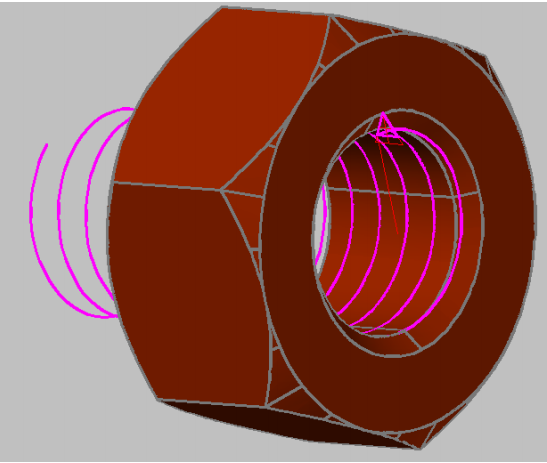TUTORIAL 4
Cut Threads
After completing this tutorial, you will be able to:
• Use the new 3D Modeling
tools in AutoCAD 2007 for
Helical cutting.
Before starting this tutorial, you should have been able to:
• Use AutoCAD at an intermediate
to advanced level
• Manipulate the DUCS
• Use the Helix tool
• Sweep Solids
One of the most common
questions that comes up when beginners are learning
AutoCAD 3D is how to create
a cut thread. The new 3D modeling tools in AutoCAD
2007 allow you to model true helical
paths that previously were not possible to model in
AutoCAD. This tutorial
assumes that the user is completely familiar
with creating
precise 2D sketches
of arcs, lines, polylines, and splines
in any location
as well as the 3D
tools from previous releases.
|
1. Open
the file named Tutorial
4 Threads.dwg. We are going to cut M10 x 1.5 threads. Check the Machinery’s Handbook
for complete information on thread forms.
Figure 1
2. Turn off all layers
except the Rod Sketch and Rod
Solid layers and make the Rod Solid layer the
active layer. Revolve the Rod
Sketch as shown.
Figure 2
3. Turn
on the External Threading
Tool and Helix Path layers, Make the Helix Path
layer the active layer.
Select the Helix tool and then select the Center snap point of
the end of the rod. (Tip:
By selecting a circle
center point we automatically set the
z‐axis perpendicular to the circle if
DUCS
is turned on.)
Figure 3
4. Then select the Intersection of the corner of the cutting tool as the base radius.
Press enter to accept the same distance as the top radius.
Figure 4
5. RMB
select turn Height
and enter a height
of 1.5 for the pitch of the thread.
Figure 5
6. And then track along
the axis going a couple
of turns beyond
the end of the rod. (Tip: If your z‐axis
happens to be pointing in the wrong
direction you can track the axis
of the helix by pausing
over the center of the start end and then tracking
in desired direction of the axis.)
Figure 6
7. Start the Sweep tool and select
the cutting tool sketch.
Then RMB and select
Alignment and No. Then select the helical path.
Figure 7
8. If you are going to rapid prototype the part via an stl file you might want to
make a copy of the thread cut shifted
along the axis the desired
clearance distance.
Figure 8
9. Subtract the Sweep and make sure the rod is on the Rod Solid layer and turn off
the other layers.
Figure 9
10. Turn off all layers except the Nut Sketch
and Nut Solid layers and make the Nut
Solid layer the active layer.
Figure 10
11. Extrude the hexagon to the center of the second
circle as shown.
(Tip: Shown in
Figure 11 in x‐ray visual style mode.
Figure 11
12. Presspull the hole through the part.
Figure 12
13. Extrude the larger circle that is tangent to the hexagon with a taper
of 45° (or 45°)
beyond the length of the nut. |
Figure 13
14. Use the Intersection tool to derive
the intersection between
the two solids. This cuts
a chamfer on the nut.
Figure 14
15. Repeat the same procedure on the other side.
Figure 15
16. Add a 0.75mm Chamfer to both ends of the hole in the nut.
Figure 16
17. Turn the Internal Threading Tool layer on. Create
a new Helix path for the
internal threading tool.
Figure 17
18. Sweep the cut tool and subtract as was done with the external thread.
Figure 18
Figure 19




















0 Response to "Tutorial AutoCad 2007 Cut Threads (part-4)"
Post a Comment